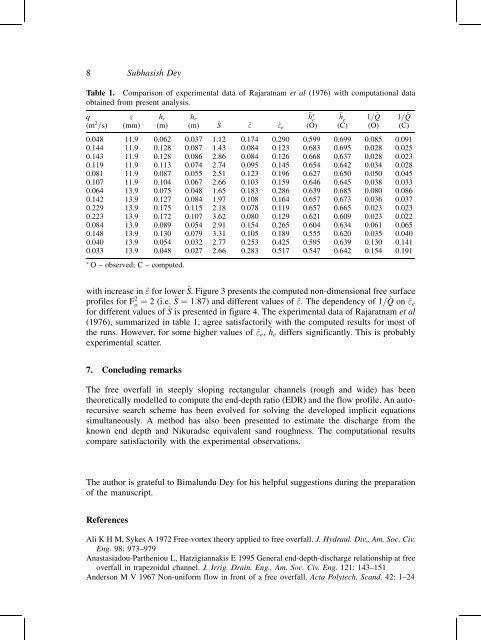End depth in steeply sloping rough rectangular channels
End depth in steeply sloping rough rectangular channels
End depth in steeply sloping rough rectangular channels
You also want an ePaper? Increase the reach of your titles
YUMPU automatically turns print PDFs into web optimized ePapers that Google loves.
8 Subhasish Dey<br />
Table 1. Comparison of experimental data of Rajaratnam et al (1976) with computational data<br />
obta<strong>in</strong>ed from present analysis.<br />
q " h c h e<br />
~h e<br />
~h e 1=^Q 1=^Q<br />
(m 2 =s) (mm) (m) (m) ^S ~" ^" e (O) (C) (O) (C)<br />
0.048 11.9 0.062 0.037 1.12 0.174 0.290 0.599 0.699 0.085 0.091<br />
0.144 11.9 0.128 0.087 1.43 0.084 0.123 0.683 0.695 0.028 0.025<br />
0.143 11.9 0.128 0.086 2.86 0.084 0.126 0.668 0.637 0.028 0.023<br />
0.119 11.9 0.113 0.074 2.74 0.095 0.145 0.654 0.642 0.034 0.028<br />
0.081 11.9 0.087 0.055 2.51 0.123 0.196 0.627 0.650 0.050 0.045<br />
0.107 11.9 0.104 0.067 2.66 0.103 0.159 0.646 0.645 0.038 0.033<br />
0.064 13.9 0.075 0.048 1.65 0.183 0.286 0.639 0.685 0.080 0.086<br />
0.142 13.9 0.127 0.084 1.97 0.108 0.164 0.657 0.673 0.036 0.037<br />
0.229 13.9 0.175 0.115 2.18 0.078 0.119 0.657 0.665 0.023 0.023<br />
0.223 13.9 0.172 0.107 3.62 0.080 0.129 0.621 0.609 0.023 0.022<br />
0.084 13.9 0.089 0.054 2.91 0.154 0.265 0.604 0.634 0.061 0.065<br />
0.148 13.9 0.130 0.079 3.31 0.105 0.189 0.555 0.620 0.035 0.040<br />
0.040 13.9 0.054 0.032 2.77 0.253 0.425 0.595 0.639 0.130 0.141<br />
0.033 13.9 0.048 0.027 2.66 0.283 0.517 0.547 0.642 0.154 0.191<br />
O ± observed; C ± computed.<br />
with <strong>in</strong>crease <strong>in</strong> ~" for lower ^S. Figure 3 presents the computed non-dimensional free surface<br />
profiles for F 2 o ˆ 2 (i.e. ^S ˆ 1:87) and different values of ~". The dependency of 1=^Q on ^" e<br />
for different values of ^S is presented <strong>in</strong> figure 4. The experimental data of Rajaratnam et al<br />
(1976), summarized <strong>in</strong> table 1, agree satisfactorily with the computed results for most of<br />
the runs. However, for some higher values of ^" e , ~h e differs significantly. This is probably<br />
experimental scatter.<br />
7. Conclud<strong>in</strong>g remarks<br />
The free overfall <strong>in</strong> <strong>steeply</strong> slop<strong>in</strong>g <strong>rectangular</strong> <strong>channels</strong> (<strong>rough</strong> and wide) has been<br />
theoretically modelled to compute the end-<strong>depth</strong> ratio (EDR) and the flow profile. An autorecursive<br />
search scheme has been evolved for solv<strong>in</strong>g the developed implicit equations<br />
simultaneously. A method has also been presented to estimate the discharge from the<br />
known end <strong>depth</strong> and Nikuradse equivalent sand <strong>rough</strong>ness. The computational results<br />
compare satisfactorily with the experimental observations.<br />
The author is grateful to Bimalundu Dey for his helpful suggestions dur<strong>in</strong>g the preparation<br />
of the manuscript.<br />
References<br />
Ali K H M, Sykes A 1972 Free-vortex theory applied to free overfall. J. Hydraul. Div., Am. Soc. Civ.<br />
Eng. 98: 973±979<br />
Anastasiadou-Partheniou L, Hatzigiannakis E 1995 General end-<strong>depth</strong>-discharge relationship at free<br />
overfall <strong>in</strong> trapezoidal channel. J. Irrig. Dra<strong>in</strong>. Eng., Am. Soc. Civ. Eng. 121: 143±151<br />
Anderson M V 1967 Non-uniform flow <strong>in</strong> front of a free overfall. Acta Polytech. Scand. 42: 1±24
















